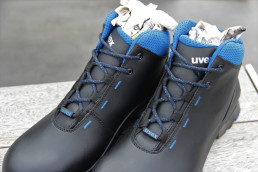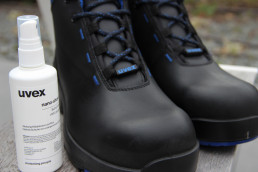People very often tend to overlook the need to maintain their work shoes, meaning they have to buy a new pair after a short period of time. Yet safety shoes and occupational footwear are very expensive, and so you need to appreciate the importance of regular cleaning, since correct maintenance not only increases their product life, but also leads to improved wearer comfort.
Correctly storing work shoes
Safety shoes and occupational footwear are often purchased in reserve or do not need to be used over a prolonged period of time. You should therefore ensure shoes are stored correctly in these cases. However, safety shoes and occupational footwear should never be stored for too long as their protective properties change with age, meaning that the outsole in particular will no longer meet the necessary requirements.
However, if you have no choice but to store your safety shoes and occupational footwear, they should be kept in a cardboard box. They are not suitable for storage in plastic bags as this can lead to the formation of mould.
Furthermore, the storage temperature must not exceed 25°C and the air humidity must be no more than 70%.

Cleaning and maintaining work shoes
In order to maintain safety shoes and occupational footwear correctly, it is particularly important to air and dry them well after each use – leather shoes will take at least 24 to 48 hours to dry out completely. It is therefore advisable to use a second pair of safety shoes. Due to these longer regeneration phases, this also extends the respective useful life of the shoes.
The place where shoes are dried is also an important factor. Wet shoes must under no circumstances be dried on a heater or using a fan heater or shoe dryer. Leather shoes in particular will become hard and brittle as a result, which will cause the shoe to wear out prematurely. They should therefore be dried in a well-ventilated space.
If your work shoes are wet, undo them fully and then stuff them with paper. Leave them to dry slowly and, if necessary, replace the wet paper until the shoes are completely dry.
Heavy soiling should be carefully removed from the work shoes before drying using a brush and lukewarm water, since dirt can have a severe impact on their breathability, affecting the climate within the shoe. After cleaning, we recommend treating the shoes with standard care products and an impregnating agent – uvex shoe add on 9698100 is ideal.

Useful life of work shoes
People very often tend to overestimate the useful life of safety shoes and professional footwear. Even if you think that your shoes are still in good condition and can definitely be worn for another few months or years, you should adhere to the following information:
It is generally not possible to give an expiration date due to a variety of factors. As a guide, you should assume five to eight years from the date of production. This useful life is dependent on the degree of wear and tear, the area of application and external factors such as heat, cold, moisture, UV radiation, chemical substances and mechanical loads.
The shoes must be checked for externally visible damage before each wear and replaced if any damage is present – e.g. integrity of outer shoe material and outsole, sufficient tread, functionality of fasteners (where applicable).
But how can you find out how old a shoe is? The label on the underside of the tongue of any given shoe contains information including the production date, written as production month/production year.
If time is up for your safety shoes or professional footwear, you should replace them with new shoes immediately.
Further information on the useful life and product life of safety shoes can be found in our blog article “Why do shoe soles disintegrate?”.
What has been your experience when it comes to maintaining your safety shoes? Let us know in the comments.
Your shoes should also be clean and shiny. And the method shown in this article to keep your shoes clean and shiny is very well.
I always pack my shoes with plastic before storing them. this way I ensure no dust can harm my shoes and it can remain as it is.
Well said. Maintenance for shoes is a must!